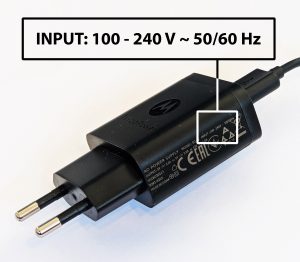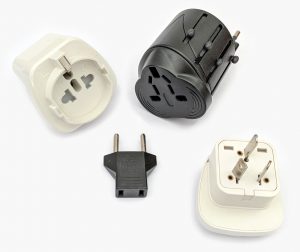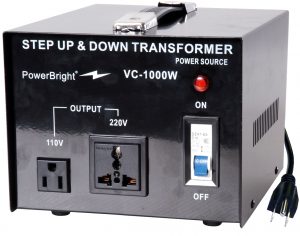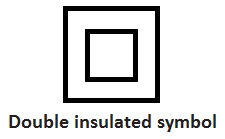Useful information for travellers

Only use plug adapters if the local mains voltage is the same as at home or if you need to power a multi-voltage device. The above charger is multi voltage: it will work with any voltage between 100 and 240 volts.

Travel adapters do NOT convert the voltage!
What do I need to use my appliances abroad?
What do I need to use my appliances abroad? What is the difference between a plug adapter and an electric converter? Here are the facts. First the good news: in many cases you may not need to carry much with you at all…
Plug adapters (or travel adapters)
Travel adapters simply allow a device from one country to be plugged into the wall outlet of another country. However, they do not convert electricity. The plug of a Continental European appliance will not fit into an outlet in a foreign country without a plug adapter. Since a travel adapter does not convert the voltage, you have to be sure that your appliance can deal with the electricity coming out of the socket. That is why you need to check your device’s voltage listing. “INPUT: 100-240 V” means that your device is multi-voltage and that it will work with any voltage between 100 V and 240 V. Luckily, many travel gadgets (such as laptops or phone chargers) are multi or dual voltage, so you will only need a travel adapter. If your device is single voltage (e.g. “INPUT: 120V”) and you are in Europe where the mains voltage is 230 V, you will need to step down the voltage. Enter the converter or transformer.
Converters
Converters and transformers both step up or down the voltage, but there is a difference in use between them. Converters should be used only with “electric” products. Electric products are simple heating devices or have mechanical motors. Examples are hair dryers, steam irons, shavers, toothbrushes or small fans. Converters are not designed for “continuous duty” and should only be used for short periods of time (1 to 2 hours). Additionally, most converters can only be used for ungrounded appliances (2 pins on the plug). Converters must be unplugged from the wall when not in use.
Transformers
Transformers also step up or down the voltage, but they are more expensive than converters and are used with “electronic” products. Electronic products have a chip or circuit. Transformers can also be used with electric appliances and may be operated continually for many days. The advantage of converters, however, is that they are lighter and less expensive.
Computers are electronic devices and therefore they must be used with a transformer, unless they are dual voltage. Fortunately, nowadays all laptop, tablet and phone chargers are dual voltage, so they can be used with only a travel adapter.
Transformers are sold in various sizes based on how much wattage they can support. Therefore you must pay careful attention to the wattage ratings of the appliances to be plugged into a transformer. The wattage rating of the transformer should always be larger than the wattage rating of the appliance to be plugged into it (plus a 25% buffer to allow for heat build-up in the transformer or converter). When plugging multiple items into a power strip, then into the transformer, you have to calculate the combined wattage of all appliances and the power strip, then add an additional 25% to that total.

The appliance’s voltage and wattage requirements are listed on the manufacturer’s label located on the back or at the bottom of the appliance. In some cases, the voltage and amperage will be listed, but not the wattage. If this is the case, simply multiply the voltage by the amperage rating to find the wattage rating (e.g. 230 V * 2 A = 460 W).
Below is a list that gives an idea what the wattage of common appliances is. Use this as a guide only. Always check your appliance first!
- 100 watts (or less): small, low-wattage appliances such as small fans, printers and desktop computers.
- 300 watts: most TVs, electric blankets and refrigerators.
- 500 watts: blenders, projectors and home cinema systems.
- 1000 watts: small heaters and stand mixers.
- 1600 – 2000 watts: hair dryers, dishwashers, washing machines, vacuum cleaners, most appliances that have heating elements such as convector heaters, toasters, deep-frying pans, irons, grills and coffee makers.
- 3000 watts: tumble dryers and big air conditioners.
Transformers and converters only convert the voltage, not the frequency. The difference in cycles may cause the motor in a 50 Hz appliance to operate slightly faster when used on 60 Hz electricity. This cycle difference will cause electric clocks and timing circuits to keep incorrect time: European alarm clocks will run faster on 60 Hz electricity and American clocks will lose some 10 minutes every hour when used in Europe. However, most modern electronic equipment like phone chargers, laptops, printers, etc. are usually not affected by the difference in cycles and adjust themselves automatically.
Italy: Power adapters, plugs and converters
Different countries have different standard electricity supplies, which means the voltage and frequency, and plug type used vary around the world. If you want to use your normal home appliances – a laptop, hairdryer or phone charger, for example – while you’re traveling, you may need power adapters or converters.
Don’t get stuck, watching your phone battery life slowly dwindle away, unable to recharge. And don’t leave yourself hunting for a US compatible adapter in your destination, where you’ll pay more and have fewer options to choose from.
This guide covers the basics for travel to Italy. Read on for more about the standard voltage for Italy, plug styles, and the types of US to Italy power adapters available.

Off to Italy? Save money with Wise
Checking you have the right plug adapters and converters needed for your trip will save you money and hassle. Another way to cut the costs of travel is to get a free Wise multi-currency account before you leave.
You’ll be able to hold 40+ currencies, switch between them using the mid-market exchange rate, and spend easily using your linked debit Mastercard. Save on foreign transaction fees, and leave yourself with more to spend while you travel.
| Wise’s multi-currency Mastercard can be up to 4x cheaper when spending abroad, compared to banks and PayPal |
|---|
Electricity in Italy
If you’re planning a trip overseas, it helps to know a bit about the electricity supply and plug type used in your destination. Here’s what you need to know about Italy.
Voltage/Frequency in Italy
Thanks to quirks of history, there is no standard voltage for electricity around the world.¹ That means that electrical appliances may be designed differently from one market to another – and also might mean that you need to take extra steps to use your appliances when you travel.
In Italy, electricity supplies run on 220V – 230V, with 50Hz the standard frequency. This is in contrast to here in the US, where 120 V, 60Hz electricity is used. We’ll cover why this matters – and what you can do about it, in a moment.²
Plug types in Italy
Plug styles also vary globally. To help keep track, the different types are assigned letters to identify them. Italy uses plug types F and L, which both take plugs with round pins. Plug type F is round, with holes for 2 round pins, and L is rectangular with space for 3 round pins. You can also use plug types C and E in some sockets in Italy.³
For reference, US appliances use type A or B plugs, which can’t usually be used in Europe as they have flat pins instead of round.⁴
Adapters used in Italy
If you’re about to go to Italy, it may be a smart idea to buy one or two adapters for your regular appliances. You’ll be able to find universal adapters which fit most standard plug types – but are relatively expensive – or adapters which specifically fit one of Italy’s standard plug types. Buying online is the best way to get a good deal on adapters.
It’s worth knowing that the different voltage between the US and Europe can also mean that appliances made for the American market don’t function optimally in Italy. If you’re staying in a hotel while you travel, you may be better off borrowing appliances while you’re there, rather than taking your own. More on that below.
Power adapters for Italy
Let’s take a look at what matters, if you need a power adapter for Italy.
Power adapters are used to let you plug your device into a different type of plug socket. However, they won’t change the voltage and frequency of electricity which is supplied, which could still mean your appliance doesn’t work properly or is damaged.
Check the voltage of your appliance before you pack it. Many modern electrical devices have dual voltage rating, which means they can be used in different regions of the world. Look for a sticker on your device which says something like ‘INPUT 110V – 240V’. This shows that the device can cope with electricity supplied at anything between 110 and 240 volts, making it safe for use in both the US and Italy.
Appliances requiring an earth connection
It’s worth noting that some travel adapters can not be used on devices which require an earth connection. These adapters are intended only for use on appliances which are double insulated, meaning there is an extra layer of protection between the electrical wiring and any area you might touch. Double insulated equipment often includes things like blenders, blow dryers and power tools – look for the symbol on the appliance to show it has double insulation.⁵
Power converters or transformers
You may decide to buy a power converter or transformer for your trip to Italy. These are devices which switch the voltage of the electricity supply which comes from the wall, to match the requirements of your device. As we mentioned above, many modern devices are actually able to accept a range of voltages and still function perfectly well, so you may not need to worry about a converter at all.
If you do decide to get an Italy power adapter/converter, check you’re buying the right type for the device you want to use. A converter is usually used for a short while only, while a transformer can be plugged in and left to run continuously for longer.
Some of the options available are quite bulky and heavy, making them a poor choice for people who want to travel light. Shop around online to find one which fits your needs, for the best available price.
No matter where in the world you’re planning on visiting, you’ll make life easier – and save money – with some advance research. Forgetting your power adapter could mean you struggle to use essential devices or even charge your phone – and need to spend more than you need to, to buy an adapter in the airport or at your destination.
Don’t forget to also check out how you can save with a Wise multi-currency account. Send, receive and spend money all over the world, conveniently, and without any hidden fees.
All sources last checked on 18 March 2020
This publication is provided for general information purposes only and is not intended to cover every aspect of the topics with which it deals. It is not intended to amount to advice on which you should rely. You must obtain professional or specialist advice before taking, or refraining from, any action on the basis of the content in this publication. The information in this publication does not constitute legal, tax or other professional advice from TransferWise Limited or its affiliates. Prior results do not guarantee a similar outcome. We make no representations, warranties or guarantees, whether express or implied, that the content in the publication is accurate, complete or up to date.
Travel Adaptor for Europe
With so much to see and do, discovering all the delights of Europe can take a bit of planning. It’s important to arm yourself with knowledge, to make sure you see all the delights this continent has to offer.
Europe travel adaptors: which type do I need?
You will need to consider what to pack, to ensure you can use your personal electrical appliances safely whilst abroad. This normally includes the use of a travel adaptor, which is a device that simply allows you to plug any UK electrical appliance into a foreign electrical socket. It is important to note that it does not convert the voltage or frequency.
For Europe the associated travel adaptor is type C, which is the plug which has two round pins. However, we recommend you check the information for the destination you’re travelling to on our travel adaptors page.

Voltage converters and transformers
Electricity supplies worldwide can vary from anything between 100V and 240V. It can be extremely dangerous to use an electrical appliance that is rated at a voltage different from the supply.
Converters and transformers perform a similar function, but their applications differ. Converters are typically used with appliances that operate for a short duration (1-2hours), whilst most transformers can be used alongside appliances that operate continuously.
As voltage can differ from country to country, you may need to use a voltage converter or transformer. You can determine whether you’ll need to use a converter or transformer, by researching the voltage used in the destination you’re travelling to on our travel adaptors page.
Double insulated equipment
It’s important to understand that some travel adaptors are not suitable for any appliances that require an earth connection. These types of travel adaptors should only be used with double insulated equipment, which will be clearly marked with the symbol shown below.

Share this article:
©2022 Electrical Safety First is the campaigning name of the Electrical Safety Council, a registered charity in England and Wales (No. 257376) and Scotland (No. SC039990) | Privacy Policy
Source https://www.worldstandards.eu/electricity/information-for-travellers/
Source https://wise.com/us/blog/italy-power-adapter
Source https://www.electricalsafetyfirst.org.uk/guidance/advice-for-you/when-travelling/travel-adaptor-for-europe/